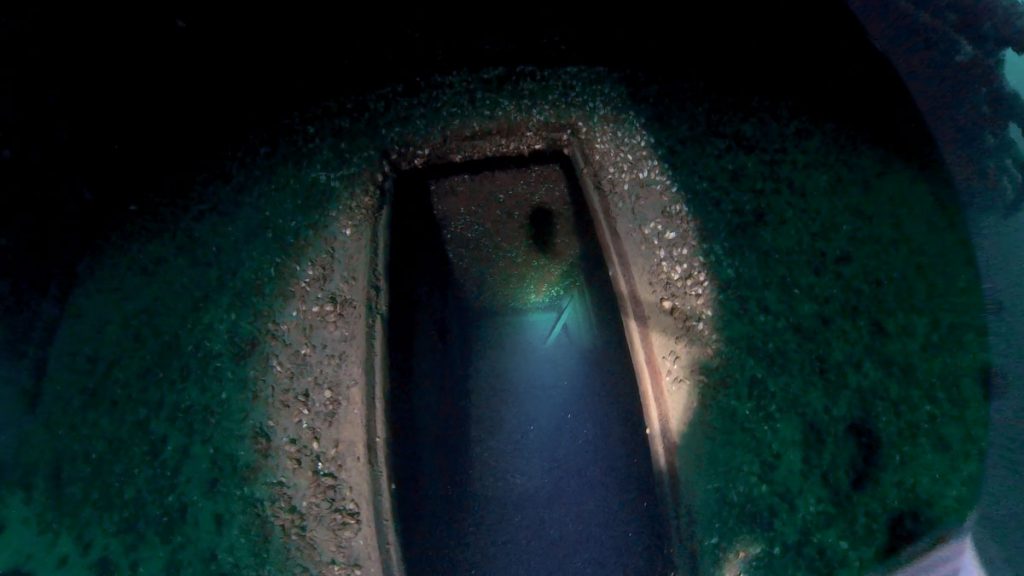George Whelan
Lost: 07/29/1930 Depth: 145

The 220′ steel steamer George Whelan was built in 1910 by the Toledo Shipbuilding Company, and registered in the US under the name “Irwin Fisher”. By 1916 she had changed hands and was now under UK registry named “Bayersher”. In 1921 she changed hands again, and now served in the first World War for the French under the name of “Port De Caen”. The following year, she was returned to this side of the pond and named again, Bayersher, this time under Canadian registry. Confused yet? By 1923 she was again sold and renamed “Claremont” and transported for the Dominican Sugar Company until 1929 when she was sold yet again. She was now under US registry, owned by the Kelley Island Lime and Transport Company and named Irwin Fisher again. She was refitted as a sandsucker, and returned to service in 1930 under the name of “George Whelan”.
On July 29th, 1930, the Whelan was on her first voyage after being put back into service as a sandsucker. She was bound Sandusky, OH for Tonawanda, NY when a violent squall developed. The wind ripped up the lake and the thunder rolled. Around midnight, her cargo of limestone had shifted and she was listing dangerously to port. Several of the crew were sent bellow with shovels to try to redistribute the load in an attempt to right the ship. A sudden gust of wind and waves rolled the ship onto her side, throwing the six survivors into the water, where they clung to the ship for nearly a half hour before the ship sank. It’s thought that the other fifteen crew members were trapped bellow decks, probably in the cargo holds. The survivors began swimming for shore in the dark of night when a steamer bound for Erie Pa heard their cries for help. With the aid of a search light, the were able to locate the survivors, and brought them aboard.
The ship had rested at the bottom of the lake for over 75 years, her position unknown. Many divers had attempted to find her over the years, but conflicting reports of where she had gone down had most on a wild goose chase. On Thursday, October 13th, 2005, we teamed with side-scan sonar expert Gary Kozak of Klein Associates to search an area we believed held the resting place of this lost ship. Using a Klein system 3000 side-scan, the same type of state-of-the-art imaging sonar used to find the Titanic, Gary laid out a grid-like paten for us to follow. The conditions were perfect for this operation, and we were able to cover every inch of 32 square miles in a single day. Hours went by staring at a computer monitor, occasionally taking in the unusually pleasant October weather. We were beginning to wonder if we were going to find anything at all, when Gary turned and said matter-of-factly, “Gentlemen, you have your wreck.”. There on the screen was an image, almost as clear as a photograph, of the ship that had been missing for three quarters of a century.
October weather on Lake Erie can be ruthless, and by the weekend following our discover of the Whelan, the lake turned ugly and stayed that way for over a week. We were beginning to wonder if we’d get to dive this wreck before the end of the season, when the forecast showed some hope. The calls were made to “The Usual Suspects” (our core regulars) to be the very first to ever dive this virgin wreck. Most divers never get an opportunity like this, so most took leave of their responsibilities and jumped at the chance to be the first (I had to wait until the second trip, a couple days later).
The Whelan now lies 3/4 over on her port side in 150′ of water off Barcelona, NY. This is a true virgin site, she hasn’t been stripped of anything. Whatever was on the ship when she went down is still there. There are lanterns, life rings, port holes, anchor, life boat, railings, stairways, doors and hatches. There’s a huge propeller and rudder. There are also many opportunities for penetration, for those trained in this type of diving. Visibility is normally in the range of 30-60 feet, bottom temps in the low 40’s.
ZONE: 1

